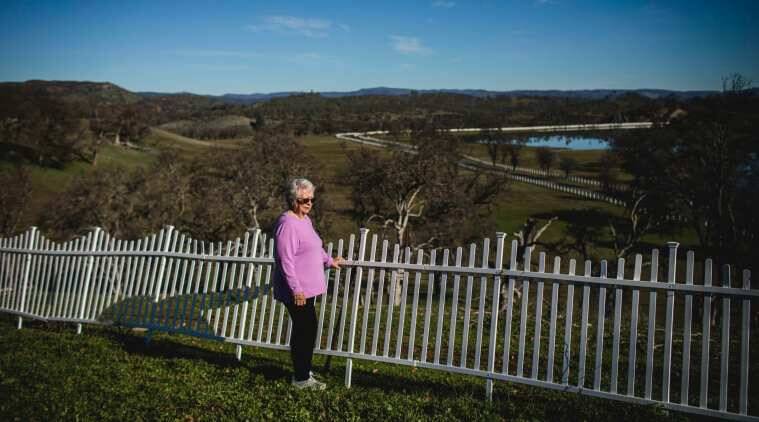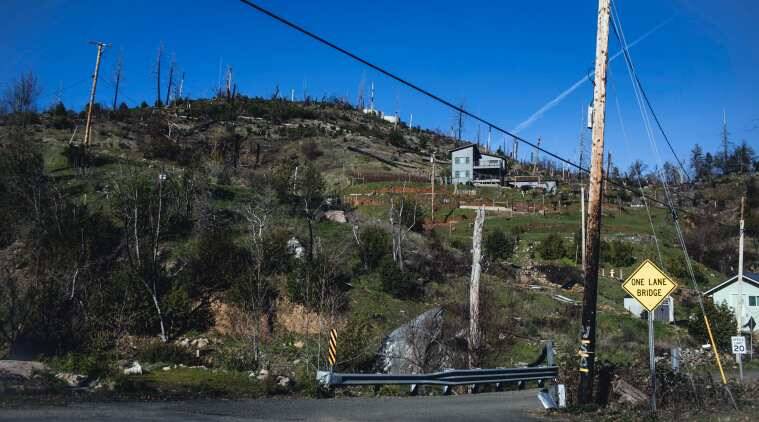Written by Sophie Kasakove
When Pat Donley learned about the proposed 16,000-acre luxury development that would border her ranch in the burn-scarred hills of Northern California, her mind raced back to the terrifying hour she spent in bumper-to-bumper traffic while fleeing the Valley Fire in 2015, as a barrage of flames advanced down either side of the road.
After that narrow escape, Donley and her husband moved from their gated subdivision to a place that at least offered a less crowded escape: a remote ranch off a windy, narrow road in the hilly outskirts of Middletown.
https://images.indianexpress.com/2020/08/1×1.png
So the news five years later that as many as 4,000 new people could be living along that two-lane canyon road seemed to her like a plan destined for disaster.
“If they put all those people on the road, there’d just be no way we could get out — we probably couldn’t even get on the road,” Donley said. “We’d be trapped.”
In rural Lake County, an area north of the famed Napa and Sonoma valleys that is known less for tourism than for poverty and unemployment, the new Guenoc Valley development — five resort hotels, a golf course, spas, polo fields and hundreds of villas arrayed around a historic vineyard — promised jobs and tax dollars.

 From her ranch in Middletown, Calif., Pat Donley looks out over land that recently burned and is now the proposed site of a luxury housing development on Jan. 19, 2022. (Bryan Meltz/The New York Times)
From her ranch in Middletown, Calif., Pat Donley looks out over land that recently burned and is now the proposed site of a luxury housing development on Jan. 19, 2022. (Bryan Meltz/The New York Times)
It also promised more people in an area likely to see wildfire again, and soon. The development site has burned three times in the past seven years. At least two other fires have threatened nearby communities since 2019. Donley evacuated her new home in 2020, when the LNU Lightning Complex Fire tore through the Guenoc Valley project site, leaving patches of charred, leafless trees.
But critics of new development in wildfire-prone areas of California scored an important victory this month when a Superior Court judge blocked the Guenoc Valley development, concluding that thousands of new residents in the area could contribute to a deadly bottleneck during an evacuation.
The decision is the latest in a series of groundbreaking new legal rulings that are putting the brakes on development in the more remote areas of a state that has seen the two most destructive fires in its recorded history in the past five years.
Check Out Express Premium
Click here for more
In October, a San Diego judge struck down the approval of a community of more than 1,000 homes and businesses in that county’s dry eastern scrublands because of wildfire risk. In April, a Los Angeles judge overruled the county’s approval of a 19,300-home community in the fire-prone Tehachapi Mountains.
The successful legal challenges have emerged as a powerful new tactic for state government to control development in wildfire-prone areas — places where building decisions are typically made by local officials who also face pressure to provide affordable housing, economic development and tax revenues.

 Anderson Springs, Calif., just outside of Middletown, on Jan. 19, 2022. Anderson Springs lost 90 percent of its homes in the Valley fire in 2015. (Bryan Meltz/The New York Times)
Anderson Springs, Calif., just outside of Middletown, on Jan. 19, 2022. Anderson Springs lost 90 percent of its homes in the Valley fire in 2015. (Bryan Meltz/The New York Times)
“A lot of people are wishing and hoping that wildfire risk wasn’t the new reality and haven’t quite adapted to the fact that it is,” said Attorney General Rob Bonta, whose office joined private environmental organizations in two wildfire lawsuits in San Diego County, as well as the challenge in Lake County. Developers “are building projects based on planning and thinking that was cemented and used well before wildfire risk became so prevalent and so common and so real,” he said.
The lawsuits came after a change in 2018 to the California Environmental Quality Act that emphasized wildfire as a factor that must be considered during environmental reviews.
“We’re at a kind of inflection point between the legacy of the 20th century and the imperatives of the 21st century,” said Stephanie Pincetl, director of the California Center for Sustainable Communities at UCLA. “No, you can’t just develop whatever you want to because you want to — that’s over. There’s no accountability in that over the long term.”
Despite the growing number of wildfires worsened by climate change in recent years, development in fire-prone areas has continued largely unabated, and not just in California. Across the United States, an estimated 99 million people in 2010 lived in areas where development runs up against wildland, according to the Agriculture Department.
That number has most likely grown since then, as high housing costs and COVID-19 risks have pushed more people into rural areas. The risks of such encroachment were put on disastrous display in Colorado in December, when fires destroyed hundreds of homes in the suburban sprawl near Boulder.
Despite the risks, most regulation has involved requirements for fire-safe construction and vegetation clearing. In California, those codes — among the strictest in the country — have been broadly successful: A home built after the state updated its wildfire standards in 2008 is 40% less likely to be destroyed than a 1990 home with the same exposure, according to a December study from the National Bureau of Economic Research.
But those protections are not always a match for the high-speed fires that have torn through Northern California in recent years. During the Camp Fire, which swept through the small town of Paradise in 2018, homes built before and after the code came into effect were destroyed at roughly similar rates: 37% of homes built between 1997 and 2008 survived, while 44% of homes built between 2008 and 2018 did, according to a study by the U.S. Forest Service.
The fires now sweeping through the state with staggering regularity are leading some to wonder whether some places are simply too dangerous to build in at all.
“I think we have to be open to that possibility and look at the data and the science,” Bonta said, “and if it’s worth it in terms of loss of life and loss of property and loss of health. There might be some places where we shouldn’t build.”
The state’s legal challenge does not necessarily mean that Middletown is one of them, Bonta said, noting that his office would support new development there if the developer and county could address the evacuation concerns.
For some in Middletown, the state intervention threatens the community’s attempt to bounce back from the economic devastation of repeated wildfires.
All over town, address markers sit in front of vacant lots where houses destroyed by the Valley Fire once stood. Many residents never returned; others have lived in recreational vehicles on charred properties ever since. Real estate offices received a surge of interest during the pandemic from people hoping to escape the San Francisco Bay Area, but there were few houses to offer.
“Rural communities like those in Lake County may increasingly become ghost towns, as residents leave to find work,” Moke Simon, a Lake County supervisor, warned recently.

 A store in Middletown, Calif., on Jan. 19, 2022. Middletown, like many rural communities in Lake County, has struggled to bounce back from the economic devastation of repeated wildfires. (Bryan Meltz/The New York Times)
A store in Middletown, Calif., on Jan. 19, 2022. Middletown, like many rural communities in Lake County, has struggled to bounce back from the economic devastation of repeated wildfires. (Bryan Meltz/The New York Times)
The environmental advocates opposing the Guenoc Valley project argue that its benefits will not be felt by existing residents.
“There are no houses here for firefighters and nurses and schoolteachers — this is luxury resorts and luxury low-density homes,” said Peter Broderick, an attorney with the Center for Biological Diversity, which brought the lawsuit.
But many Middletown residents, like Rosemary Cordova, see a benefit to bringing in new people to help revive a town whose inhabitants have been drawn closer by disaster.
“We rely on each other — the interdependence is nourished by the community,” she said.
That was what prompted her to rebuild in Middletown, she said, after the Valley Fire destroyed part of her home and burned a property she owns next door to the ground.
She has been persuaded by presentations from the Guenoc Valley developer, Lotusland Investment Holdings, that showed its plans to build its own fire station, clear vegetation and put utilities underground.
The county declined to comment on the litigation and did not say whether it planned to appeal the judge’s ruling, but Simon, whose district includes the Guenoc Valley site, said the county would “continue to welcome any future opportunities to partner with Lotusland and others to promote thoughtful development.”
Chris Meredith, one of the development partners, said they were reviewing the court ruling and “remain committed to working alongside the Lake County community and fire safety experts to ensure this project is built in the right way to improve wildfire detection, prevention and response throughout the region.”

 Middletown, Calif., which, like many rural communities in Lake County, has struggled to bounce back from the economic devastation of repeated wildfires, on Jan. 19, 2022. (Bryan Meltz/The New York Times)
Middletown, Calif., which, like many rural communities in Lake County, has struggled to bounce back from the economic devastation of repeated wildfires, on Jan. 19, 2022. (Bryan Meltz/The New York Times)
Local fire officials agree that fire risks in outlying areas can be minimized by building carefully and maintaining rigorously.
Mike Wink, a chief for the state firefighting department, Cal Fire, lives in Middletown, where his family goes back four generations. As he drives around town, he can easily identify the structures that survived the Valley Fire, and those that would be likely to survive another blaze.
“The folks and the places that do the maintenance and keep the noncombustible area around the home,” he said, “the probability of more of those new homes surviving is significant.”
One argument in favor of new development in outlying areas is that it can provide firefighters with access roads and more eyes on the ground to help put out wildland blazes more quickly.
But those arguments are not necessarily winning the day in court challenges.
The developers should have considered how many more people would be trying to escape during a wildfire, Judge J. David Markham wrote in the Guenoc Valley case. “The additional people competing for the same limited routes can cause congestion and delay in evacuation, resulting in increased wildfire-related deaths.”

